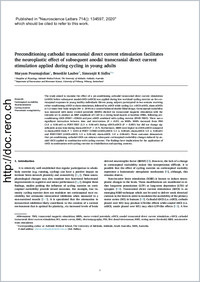Preconditioning cathodal transcranial direct current stimulation facilitates the neuroplastic effect of subsequent anodal transcranial direct current stimulation applied during cycling in young adults
- Pourmajidian, Maryam Discipline of Physiology, Adelaide Medical School, The University of Adelaide, Australia
- Lauber, Benedikt Department of Neuroscience and Movement Science, University of Fribourg, Switzerland
- Sidhu, Simranjit K. Discipline of Physiology, Adelaide Medical School, The University of Adelaide, Australia
-
01.01.2020
Published in:
- Neuroscience Letters. - 2020, vol. 714, p. 134597
English
The study aimed to examine the effect of a pre-conditioning cathodal transcranial direct current stimulation (ctDCS) before subsequent anodal-tDCS (atDCS) was applied during low workload cycling exercise on the corticospinal responses in young healthy individuals. Eleven young subjects participated in two sessions receiving either conditioning ctDCS or sham stimulation, followed by atDCS while cycling (i.e. ctDCS-atDCS, sham-atDCS) at 1.2 times their body weight (84 ± 20 W) in a counterbalanced double-blind design. Corticospinal excitability was measured with motor evoked potentials (MEPs) elicited via transcranial magnetic stimulation with the intensity set to produce an MEP amplitude of 1 mV in a resting hand muscle at baseline (PRE), following pre-conditioning tDCS (POST−COND) and post atDCS combined with cycling exercise (POST-TEST). There was a significant interaction between time and intervention (P < 0.01) on MEPs. MEPs increased from PRE (1.0 ± 0.06 mV) to POST-TEST (1.3 ± 0.06 mV) during ctDCS-atDCS (P < 0.001) but did not change significantly across time during sham-atDCS (P > 0.7). Furthermore, MEPs were higher in ctDCS-atDCS compared to sham-atDCS (both P < 0.01) at POST−COND (ctDCS-atDCS: 1.1 ± 0.06 mV, sham-atDCS: 1.0 ± 0.06 mV) and POST- TEST (ctDCS-atDCS: 1.3 ± 0.06 mV, sham-atDCS: 1.0 ± 0.06 mV). These outcomes demonstrate that pre-conditioning cathodal tDCS can enhance subsequent corticospinal excitability changes induced by anodal tDCS applied in combination with cycling exercise. The findings have implications for the application of tDCS in combination with cycling exercise in rehabilitation and sporting contexts.
- Faculty
- Faculté des sciences et de médecine
- Department
- Département de Médecine
- Language
-
- English
- Classification
- Biological sciences
- License
-
License undefined
- Identifiers
-
- RERO DOC 328210
- DOI 10.1016/j.neulet.2019.134597
- Persistent URL
- https://folia.unifr.ch/unifr/documents/308502
Statistics
Document views: 95
File downloads:
- pdf: 175
